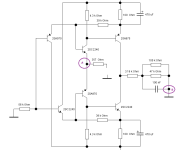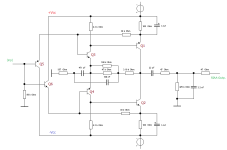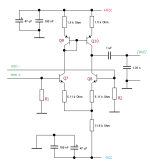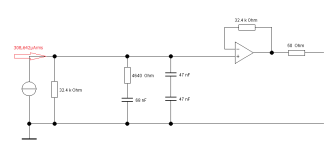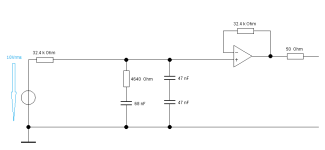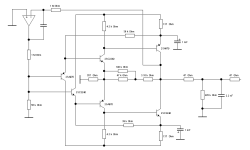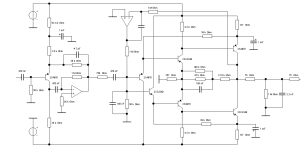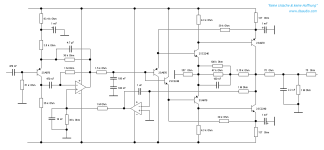This is a mismatch of several techniques.
There is a current conveyor visible composed of a diamond bufer driving two transistors that do the voltage to current conversion.
At this point a current driven Riaa network should be connected with it’s other side to gnd.
A high input impedance buffer should provide a low ohmic output impedance.
It’s output is the right point to connect a feedback resistor to the diamond output.
Feedback from the current output is not the way to go to.
Hans
There is a current conveyor visible composed of a diamond bufer driving two transistors that do the voltage to current conversion.
At this point a current driven Riaa network should be connected with it’s other side to gnd.
A high input impedance buffer should provide a low ohmic output impedance.
It’s output is the right point to connect a feedback resistor to the diamond output.
Feedback from the current output is not the way to go to.
Hans
Now one of the countless ways to couple and amplify the MM system.
Note that the output resistance interacts with the input resistance of the second stage, which is basically the current-voltage converter. At the same time, the 75µsec pole is realized here.
The entire overload reserve (margin) should be more than sufficient, so if there is no noise or distortion - build it up! Just think of Q5,6 as an impedance converter and stop thinking about diamonds.
HBt.

Note that the output resistance interacts with the input resistance of the second stage, which is basically the current-voltage converter. At the same time, the 75µsec pole is realized here.
The entire overload reserve (margin) should be more than sufficient, so if there is no noise or distortion - build it up! Just think of Q5,6 as an impedance converter and stop thinking about diamonds.
HBt.

Attachments
@Hans Polak,
what is the difference between voltage (force) and current?
HBt.
PS
Let's please continue our debate in a friendly and civilized manner for the benefit of the reading-only users. Perhaps you would like to clarify your postings (21, 22) a little more, i.e. give reasons for your statements.
what is the difference between voltage (force) and current?
HBt.
PS
Let's please continue our debate in a friendly and civilized manner for the benefit of the reading-only users. Perhaps you would like to clarify your postings (21, 22) a little more, i.e. give reasons for your statements.
Attachments
Simulations will reveal the differences.Good points Hans,
but the question is:
what is the main difference between node A and node B (the real ground)?
HBt.
Hans
Not only the simulation but also the basic knowledge and imagination.Simulations will reveal the differences.
Hans
I had actually hoped for explanatory sentences with more words than just a statement. For our readers. But so be it.
HBt.
I see...The best EQ that has ever been heard ..
Better, but not good. A good circuit has stable bias without thermal tracking or electrolytic capacitors.is it now better?
Ed
IMO at least the output buffer should have been used. It avoids troubles with lower load impedance. Without the buffer, the output impedance rises to low frequencies, because of the output from collectors and decreasing feedback factor at low frequencies.
The circuit below applies to original "design" from post #1, I did not bother with further "improved versions".

Back in the 1970, this circuit might have been a kind of fun, but not in 2025.
The circuit below applies to original "design" from post #1, I did not bother with further "improved versions".
Back in the 1970, this circuit might have been a kind of fun, but not in 2025.
Back to the year 2025, completely without CD4 (the quadrophonic sound)
Nice PMA,
then there is no hope ( "Keine Hoffnung" ) and we don't win the Pop & Click Challange this year. Then I'll just go diving in Queensland with Haudegen and maybe we'll find three pearls.
Jokes aside:
Wouldn't we just like to define the framework conditions of an equalizer suitable for 2025 and specify the data?
After all, the entire first page of this thread is nothing more than an introduction. There may still be some input from the experts in this round.
I'm looking ahead and hoping for the best.
HBt.
-Biodiversity is known to be quality of life-
OpenAmp1
Nice PMA,
then there is no hope ( "Keine Hoffnung" ) and we don't win the Pop & Click Challange this year. Then I'll just go diving in Queensland with Haudegen and maybe we'll find three pearls.
Jokes aside:
Wouldn't we just like to define the framework conditions of an equalizer suitable for 2025 and specify the data?
After all, the entire first page of this thread is nothing more than an introduction. There may still be some input from the experts in this round.
I'm looking ahead and hoping for the best.
HBt.
-Biodiversity is known to be quality of life-
OpenAmp1
Better, but not good. A good circuit has stable bias without thermal tracking or electrolytic capacitors.
Ed
Then we will inevitably have to ask a servo for help - and perhaps we will also have to air-condition the final circuit ... it's class A.
😱
Attachments
If we're going to use an op-amp anyway, why not use two of them? Now we can go back to the beginning of the development story - to the magnificent seven, seven BJTs. But, maybe there's more noise now, who knows ..!(...) The circuit below applies to original "design" from post #1, I did not bother with further "improved versions".
Operational amplifiers are actually predestined when it comes to phono EQ. Why do we like to play around with individual semiconductors so much?
HBt.
Attachments
Let us summarize briefly:
No
In addition, the input stage now offers a simple 5Hz subsonic filter. All common input impedances of standard hi-fi audio preamplifiers can be drive. There may be still need to be some tweaking here and there, but that's quite normal. The dimensioning of the first stage may need to be reconsidered - optimized in terms of noise performance, but the skeleton has been established.
By Easter at the latest, Ed, Hans & Pavel may reveal all their design secrets to us and "Keine Ursache" takes the very last evolutionary hurdle with flying colors. This species will then oust all other living creatures from the audio planet.
HBt.
No
- electrolytic capacitor in the "signal path"
- thermal instability (military standard)
- +1 error
- other, unspecified peculiarities
In addition, the input stage now offers a simple 5Hz subsonic filter. All common input impedances of standard hi-fi audio preamplifiers can be drive. There may be still need to be some tweaking here and there, but that's quite normal. The dimensioning of the first stage may need to be reconsidered - optimized in terms of noise performance, but the skeleton has been established.
By Easter at the latest, Ed, Hans & Pavel may reveal all their design secrets to us and "Keine Ursache" takes the very last evolutionary hurdle with flying colors. This species will then oust all other living creatures from the audio planet.
HBt.
Attachments
Some quick simulation data (PSPICE), with a dummy MM system:
SNR > 81 dB
Overload margin (reserve) > 25 dB
RIAA approximation (deviation) and THD are still missing. A colleague can determine that; I'm already building a prototype—but which op amps should I use? Will this year’s championship even take place?
HBt.

SNR > 81 dB
Overload margin (reserve) > 25 dB
RIAA approximation (deviation) and THD are still missing. A colleague can determine that; I'm already building a prototype—but which op amps should I use? Will this year’s championship even take place?
HBt.

Without dummy mm system now:
SNR > 82.1dB
vout = 0.5Vrms
all unrated, unweighted, but RIAA band limited !
SNR > 94.2dB
vout = 2Vrms (a little bit /like of 16bit digital audio).
So this almost completely intuitive equalizer is definitely not bad.
SNR > 82.1dB
vout = 0.5Vrms
all unrated, unweighted, but RIAA band limited !
SNR > 94.2dB
vout = 2Vrms (a little bit /like of 16bit digital audio).
So this almost completely intuitive equalizer is definitely not bad.
Even if you don't recognize it right away (because of the graphic resolution), this here is the resulting amplitude-frequency response of the equalizer project of this thread. It is maximally flat, fl is at 6Hz and all other deviations from the ideal are only a very, very few milli dBs. So they are not worth mentioning.
Attachments
- Home
- Source & Line
- Analogue Source
- "Keine Ursache" : a still immature MM phono EQ idea
